Disclosure: We may earn commissions if you purchase products after clicking on a link from our site.
Do you want to learn how to catch pollock? Pollock is a member of the cod family. It is found on both sides of the Atlantic. Pollock is more of a midwater and deep water fish than shallow waters even though you can find it there. Pollock is challenging to catch as it is a powerful fish that fights very hard when on the hook. In this article, we discuss how to catch pollock using different fishing methods, as well as give fishing tips and equipment information.
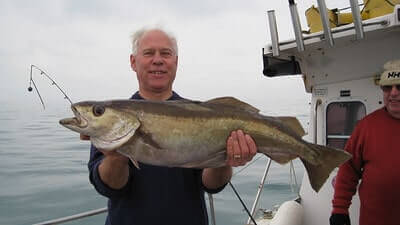
Table of Contents
How To Catch Pollock
1. Spinning
Spinning is a popular fishing method for targeting pollock, especially from shore or boats in coastal waters. Anglers typically use spinning rods and reels equipped with lures such as soft plastics, metal spoons, or plugs to entice strikes from these aggressive fish.
The technique involves casting the lure into likely areas where pollock is feeding, such as around rocky outcrops, wrecks, or underwater structures. Once the lure is in the water, anglers retrieve it using a variety of techniques, including steady retrieves, jerking motions, or a combination of both to mimic the movements of prey fish. Pollock are known for their voracious feeding habits and willingness to strike at a wide range of lures, making spinning an effective and exciting method for anglers of all skill levels.
For more information on fishing regulations and best practices for targeting pollock, anglers can refer to resources provided by government fisheries agencies like the National Oceanic and Atmospheric Administration (NOAA) at https://www.fisheries.noaa.gov/.
2. Freelining
Freelining is a versatile and effective fishing method for targeting pollock, especially in areas with strong currents or over rocky bottoms where traditional rigs may get snagged. It involves presenting a bait, typically a live or fresh baitfish such as sand eels, mackerel, or squid, without the use of weights or additional terminal tackle.
Anglers simply hook the bait and cast it out into the water, allowing it to drift naturally with the current or tide. The lack of weight allows the bait to swim freely, giving it a natural and enticing presentation that can be irresistible to hungry pollock. Freelining allows anglers to cover a lot of water and explore different depths, making it ideal for targeting pollock in a variety of environments, from shallow reefs to deep offshore waters.
It requires a sensitive touch to detect subtle bites and strikes, but the payoff can be rewarding with the potential for larger and more aggressive fish. Overall, freelining offers anglers a simple yet effective approach to catching pollock while enjoying the thrill of a direct connection between angler and fish.
3. Drifting
Drifting is a popular fishing method utilized by anglers to target pollock, especially in offshore environments with varying depths and currents. This technique involves allowing the boat to move naturally with the wind and current while presenting bait or lures to actively feeding fish.
Anglers typically rig up with weighted jigs or soft plastic lures designed to mimic the movement of baitfish, such as sand eels or herring, which are common prey for pollock. As the boat drifts over productive areas like rocky outcrops, wrecks, or underwater structures, anglers actively jig or retrieve their lures through the water column to entice strikes from pollock.
The drifting motion covers a wide area, allowing anglers to explore different depths and locate schools of fish. This method requires careful boat control and strategic positioning to effectively present lures in the strike zone. It offers anglers the opportunity to cover a lot of water and adapt to changing conditions, making it a versatile and productive technique for catching pollock in a variety of offshore habitats.
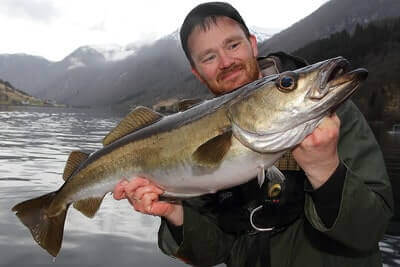
4. Float Fishing
Float fishing, also known as bobber fishing, is a versatile and effective method for targeting pollock, particularly in coastal or nearshore environments where these fish are commonly found around rocky structures or kelp beds. This technique involves suspending bait or lures beneath a float, allowing it to drift naturally with the current while remaining at a predetermined depth.
Anglers typically rig up with baitfish such as sand eels, herring, or squid, which are commonly preyed upon by pollock. The float serves as a visual indicator, signaling when a fish has taken the bait by submerging or moving erratically.
This method allows anglers to cover a wide area of water and effectively present bait or lures at various depths, enticing strikes from pollock feeding at different levels in the water column. Float fishing is particularly effective when targeting pollock near the surface or in shallower waters, where they may be actively feeding on baitfish or near structures.
It offers anglers a simple yet productive way to target pollock while providing an exciting visual element as they watch for the float to disappear beneath the surface when a fish takes the bait.
5. Fly Fishing
Fly fishing for pollock can be an exhilarating and rewarding experience, especially for anglers seeking a more challenging approach to catching these hard-fighting fish. While pollock is traditionally associated with saltwater environments, it can also be found in estuaries and nearshore areas where fly fishing techniques can be effectively applied.
Anglers typically use lightweight fly rods, reels, and lines designed for saltwater conditions, along with a variety of saltwater flies that mimic the prey items commonly targeted by pollock, such as sand eels, small baitfish, and shrimp. Fly fishing for pollock often involves casting near structures such as rocky outcrops, wrecks, or kelp beds, where these fish are known to congregate.
Anglers may employ techniques such as stripping or jigging the fly to imitate the erratic movement of prey, enticing strikes from opportunistic pollock. This method requires precision casting and careful presentation to effectively entice strikes from these fast-moving predators.
Fly fishing for pollock offers anglers a unique and immersive way to target these fish in their natural habitat, providing an exciting challenge and the opportunity to experience the thrill of hooking into these powerful and acrobatic fish on lightweight tackle.
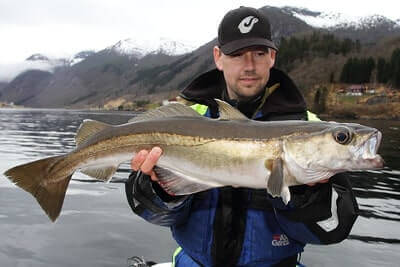
How To Catch Pollock From Shore
During spring, pollocks move to shallow waters near the shore. When you are fishing for pollocks from the shore, look for structures like jetties, breakwaters, harbors, marinas, ports, piers, and wrecks. Pollocks like structures and your chances of catching them will increase when you fish for them around structures from the shoreline.
Additionally, study the water and look for troughs, deep holes, and pockets where pollocks may be holing out waiting to ambush baitfish that come with the currents. You can send your bait into the current and let it drift along the entrance of the structures to get a bite from pollocks.
Sand eels, herrings, mackerels, and squid can be used as bait when fishing for pollock from the shore. You can use a light 1 to a 2-ounce spinning rod that is about 9 feet in length with a small 3000 fixed spool reel a 15-pound braided mainline and a 15-pound fluorocarbon leader.
Pollock Fishing At Night
You can fish for pollock at night as they are active and feed during the night. Most fish are less wary during the night and drop their guard as the fishing pressure is reduced. They see better at night and the threat of being preyed upon by seals is not high. You can use ragworms or shrimps under the float or mackerel strips to catch pollock during the night.
How To Catch Pollock From A Boat
When fishing for pollock from a boat, look for deep water wrecks. Pollock can be found around deep water wrecks where schools of baitfish congregate. The key to catching pollock is to anchor up on the structure that they are seeking cover in. Anglers then drop their bait around the structure to get a bite from pollock.
Clams, mackerel, and herring work well as bait when fishing for pollock. Jigging work when fishing for pollock and when there is little current, the results can be impressive.
Pollock Fishing Setup
A medium-heavy to heavy power, fast action fishing rod with a 45 to 55-pound braided line. A long 55 to 65-pound fluorocarbon leader that is about 4 to 5 feet will work. If you use live bait, a slow-action, heavy-powered fishing rod will get the job done.
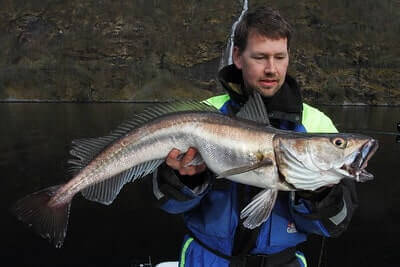
Best Baits For Pollock
1. Sand Eels
Sand eels are a favored bait for pollock fishing due to their resemblance to the natural prey of these predatory fish. These slender, elongated fish are abundant in many coastal waters, making them readily available for anglers seeking to target pollock. Sand eels can be rigged on various types of fishing tackle, including hooks, jigs, or rigs, depending on the angler’s preference and the fishing conditions.
When used as bait, sand eels are typically presented near the bottom or in midwater, where pollock is known to feed. Anglers may drift or troll with sand eel rigs, allowing the bait to mimic the natural movement of these small fish in the water column.
Sand eels can be particularly effective when fishing near rocky structures, wrecks, or other areas where pollock congregate, as these fish are often drawn to the abundant food sources found in such habitats. Overall, sand eels offer anglers a versatile and reliable bait option for targeting pollock in a variety of fishing scenarios, making them a popular choice among seasoned anglers and novices alike.
2. Herring
Herring is a widely used bait for pollock fishing, valued for its natural scent and resemblance to the preferred prey of these voracious predators. Whether fresh or frozen, herring can be rigged in various ways to entice pollock, such as on hooks, jigs, or rigs, depending on the angler’s preference and the fishing conditions.
The oily and flavorful nature of herring makes it highly attractive to pollock, which are known to actively pursue baitfish like herring in coastal waters. Anglers often present herring baits near the bottom or at midwater depths, where pollock commonly feed, using techniques such as drifting, trolling, or jigging to entice strikes.
Additionally, herring can be cut or filleted to release more scent into the water, further increasing its effectiveness as bait. When fishing for pollock, especially in areas with rocky structures or wrecks where these fish congregate, herring bait can significantly increase the chances of success for anglers targeting these prized game fish.
3. Squid
Squid is a highly effective bait for pollock fishing, renowned for its versatility and appeal to a wide range of predatory fish species, including pollock. Its firm texture and strong scent make it an excellent choice for anglers targeting pollock in both saltwater and freshwater environments.
Squid can be rigged in various ways, such as whole or in strips, on hooks, jigs, or rigs, depending on the fishing conditions and the angler’s preference. Its natural movement in the water, combined with its visual and olfactory appeal, makes squid an irresistible target for pollock, which is known to aggressively strike at baitfish and squid-like prey.
Anglers often present squid baits near the bottom or at midwater depths, where pollock commonly feed, using techniques such as drifting, trolling, or jigging to entice strikes. Whether fresh or frozen, squid remains a staple bait choice for anglers targeting pollock, offering a reliable option to attract these prized game fish in various fishing environments.
4. Mackerel
Mackerel is a popular and effective bait choice for pollock fishing, known for its strong scent, oily flesh, and lifelike appearance in the water. Its natural oils disperse easily, creating a scent trail that attracts predatory fish like pollock from a distance.
Anglers often use fresh or frozen mackerel, either whole or cut into chunks or fillets, rigged on hooks, jigs, or rigs to target pollock in both saltwater and freshwater environments. Mackerel can be presented near the surface, midwater, or bottom, depending on the fishing conditions and the angler’s strategy. Its firm texture and durability also make it suitable for casting, trolling, or jigging techniques.
Pollock are voracious feeders known to strike aggressively at baitfish like mackerel, making it an excellent choice for anglers seeking to entice these prized game fish. Whether fishing from shore, boat, or kayak, mackerel remains a go-to bait option for targeting pollock and other predatory species in various fishing situations.
5. Shrimp
Shrimp is a versatile bait option for pollock fishing, offering a natural scent and lifelike movement that can entice these predatory fish. Anglers often use fresh or frozen shrimp, either whole or peeled, threaded onto hooks or jigs to target pollock in both saltwater and freshwater environments.
Shrimp can be presented at different depths in the water column, from near the surface to the bottom, allowing anglers to adapt to changing conditions and fish behavior. Its soft texture and appealing odor make it an effective bait choice, especially when targeting finicky or selective feeders like pollock.
Whether drift fishing, casting, or jigging, shrimp can attract strikes from pollock and other game fish, making it a valuable addition to any angler’s tackle box. Additionally, its availability and ease of use make shrimp a popular bait option for anglers of all skill levels seeking success in pollock fishing endeavors.
6. Clams
Clams are a natural and effective bait choice for targeting pollock, prized for their strong scent and durability on the hook. Anglers often use fresh or frozen clam meat, either whole or chopped into smaller pieces, to entice pollock in both saltwater and freshwater environments.
The strong aroma released by clam meat can attract pollock from a distance, making it an ideal choice when fishing in areas with strong currents or murky waters where visibility may be limited. Additionally, the firm texture of clam meat allows it to stay on the hook well, even when cast or trolled at higher speeds.
Whether bottom fishing, drift fishing, or jigging, anglers can present clam bait effectively to target pollock throughout various depths of the water column. Its natural appeal and availability make clam bait a reliable option for anglers looking to hook into these prized game fish.
7. Crabs
Crabs can be an excellent bait choice for targeting pollock, particularly in coastal and estuarine environments where these fish are abundant. Whether using live or fresh dead crabs, they emit a strong scent that can attract pollock from a distance.
Anglers often use various types of crabs such as green crabs, rock crabs, or even soft-shell crabs, depending on availability and local preferences. The natural movement of live crabs can also add an enticing element to the presentation, making them irresistible to hungry pollock.
Additionally, the tough shell of crabs can withstand the rigors of casting, trolling, or drifting, ensuring that the bait remains intact and appealing to the fish. When targeting pollock, anglers can present crabs on a variety of rigs, including bottom rigs, float rigs, or even as part of a jig setup. Overall, crabs offer anglers a versatile and effective bait option for enticing pollock in diverse fishing scenarios.
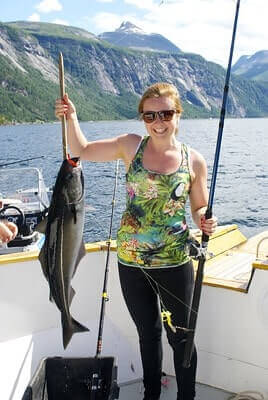
Best Pollock Lures From Shore Fishing
1. Artificial Eels
Artificial eels are a popular lure choice for anglers targeting pollock in both saltwater and estuarine environments. These lures are designed to mimic the appearance and movement of natural eels, which are a primary prey species for pollock.
Artificial eels typically come in various sizes, colors, and designs, allowing anglers to match the local forage and fishing conditions. They often feature a soft, lifelike body with a realistic swimming action that can entice strikes from even the most cautious pollock.
Anglers can fish artificial eels using a variety of techniques, including casting, trolling, or drifting, depending on the preferred fishing style and prevailing conditions. Additionally, artificial eels are durable and can withstand multiple strikes and encounters with toothy predators like pollock. Overall, artificial eels are a versatile and effective lure option for anglers seeking to target pollock in a range of fishing environments.
2. Jelly worms
Jelly worms are a unique and versatile lure option for anglers targeting pollock in both saltwater and estuarine environments. These soft plastic lures mimic the appearance and movement of various prey species, making them highly effective in enticing strikes from hungry pollock.
Jelly worms come in a wide range of colors and sizes, allowing anglers to match the local forage and fishing conditions. They feature a soft, flexible body that produces a realistic swimming action in the water, which can attract the attention of nearby pollock.
Anglers can fish jelly worms using a variety of techniques, including casting, jigging, or trolling, depending on the preferred fishing style and prevailing conditions. Additionally, jelly worms are durable and can withstand repeated use, making them a cost-effective option for anglers looking to target pollock regularly. Overall, jelly worms are an excellent choice for anglers seeking to entice strikes from pollock and other predatory fish species.
3. Scallywags
Scallywags are a type of lure specifically designed for targeting pollock, a popular species among saltwater anglers. These lures typically feature a slender, elongated body with a realistic fish-like appearance, complete with intricate detailing and vibrant colors to attract the attention of pollock.
The scallywag’s design allows it to imitate the movement of injured or fleeing baitfish, which can trigger predatory instincts in pollock and entice them to strike. Anglers can fish scallywags using various techniques such as casting, jigging, or trolling, depending on the fishing conditions and the angler’s preferences.
These lures are typically equipped with strong, sharp hooks to ensure a solid hookset when a pollock strikes. With their lifelike appearance and enticing action, scallywags are a reliable choice for anglers looking to hook into pollock and other predatory species in saltwater environments.
4. Bandits
Bandits are a type of lure commonly used by anglers to target pollock, a popular game fish found in both saltwater and freshwater environments. These lures typically feature a slender, streamlined body with a unique diving lip that allows them to dive to specific depths when retrieved.
The design of bandits enables them to mimic the swimming action of small baitfish, making them highly effective at attracting the attention of hungry pollock. Anglers can use bandits with various retrieval techniques, including trolling, casting, and jigging, depending on the fishing conditions and the desired depth of presentation.
These lures come in a range of colors and finishes to imitate different baitfish species and match prevailing water conditions. With their realistic appearance and enticing swimming action, bandits are a go-to choice for anglers looking to entice pollock into biting and enjoy an exciting day on the water.
5. Minnow Imitation
Minnow imitations are widely used lures in pollock fishing due to their ability to mimic the appearance and swimming action of small baitfish, which are a primary food source for pollock. These lures typically feature a slender, elongated body and a lifelike swimming action that closely resembles that of a fleeing minnow.
Anglers can employ various techniques with minnow imitations, such as casting, trolling, and jigging, to effectively target pollock in different water depths and conditions. Some minnow imitations are designed to dive to specific depths when retrieved, allowing anglers to cover a wide range of water columns where pollock may be feeding.
These lures come in a variety of colors and sizes to match the prevalent baitfish species and water conditions, providing anglers with versatile options to entice strikes from pollock. Whether fishing from shore, a boat, or a pier, anglers can rely on minnow imitations to attract the attention of pollock and enjoy an exhilarating fishing experience.
6. Paddle Tails
Paddle tails are a popular type of soft plastic lure used by anglers targeting pollock. These lures feature a body with a segmented, tapered design and a paddle-shaped tail that produces a lifelike swimming action when retrieved through the water. The subtle movement of the paddle tail mimics the natural motion of wounded baitfish, making it highly attractive to predatory pollock.
Anglers often rig paddle tails on jig heads or weighted swimbait hooks to achieve the desired depth and action. Whether cast and retrieved, jigged vertically, or trolled behind a boat, paddle tails can effectively entice strikes from pollock in various fishing scenarios.
Additionally, paddle tails come in a wide range of colors and sizes, allowing anglers to match the prevailing forage and water conditions. With their realistic swimming action and versatility, paddle tails are a go-to lure choice for anglers seeking to hook into hard-fighting pollock in both saltwater and freshwater environments.

Pollock Fishing Tips
1. Spring and summer are the best times to catch pollock from the shore.
2. Pollock hunts at all water levels.
3. Immature pollocks can be found around harbors and pier walls early in their lives.
4. Pollock likes structures and can be found around structures like reef edges, pinnacles, wrecks in deep water and piers, and docks closer to the shore.
5. Spinning is one of the methods to catch pollock.
6. You want to do a steady retrieve of the lure because pollock will avoid a lure that is retrieved hastily like when you fish for bass.

7. Some of the best lures for catching pollock are artificial eels, jelly worms, scallywags, and bandits.
8. Pollock doesn’t closely inspect their prey like bass.
9. Pollock will not avoid a lure that is close to a lead weight.
10. Spinning a fresh or frozen sand eel is a very effective way to catch pollock.
11. Freelining is another effective method to catch pollock.
12. Float fishing is another method to catch pollock.
13. Give pollock time to take the bait since they usually bite the tail of a lure.

14. Pollock use the tide to find baitfish; therefore, moving your bait is important.
15. Vary the lure as pollock will avoid the same lure if it moved around it so many times.
16. Pollock is a delicate species. if you will return the fish, handle it with care in a landing net or wet cloth.
17. When fishing for pollock from piers at night, you will be more successful near or on the surface.
18. From piers, pollock will be at the level where the weed grows off the wall. If you find that level, your chances of catching pollock from the pier increase.
19. Pollock makes a powerful initial run after getting hooked. Therefore, make sure you can operate your reel’s drag.
20. Early mornings and evenings are the best time of the day to fish for pollock.
21. When using lures, calm weather conditions, like little wind or offshore wind, is best for pollock fishing.

22. Wear sturdy walking boots with enough ankle support and a good grip when fishing for pollock.
23. Always take with you a landing net when fishing for pollock.
24. If you don’t get bites for a period of time like 30 to 45 minutes, move to another area and try fishing for pollock there.
25. When sand eel stocks are low in an area, pollock will move to an area where there is abundant bait fish.
26. Pollocks hang out in schools. If you catch one, there may be many more nearby.
27. Pollocks use vegetation, broken ground, reefs, and shipwrecks as cover.
28. Pollocks can be found in all levels of the water column.
29. Pollocks are often caught at depths of 165 to 985 feet.
30. Jigging can also be used to catch pollocks.
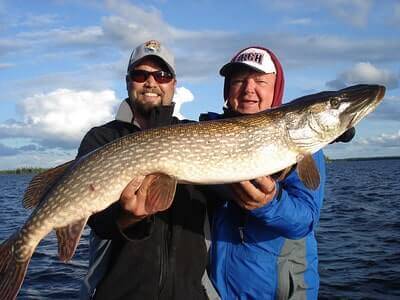
The Bottom Line
Pollock is a powerful fish that fights very hard when it is hooked. It is a member of the cod family. Pollock can be found in all levels of the water column. Pollock likes structures and when fish for it around structures to increase your chances of catching it. In this article, we discussed fishing methods to catch pollock, its behavior, tips, and equipment to catch this good-eating fish.
If you are also interested in catching other fish like kingfish, grouper, and red snapper, then read how to catch kingfish, how to catch grouper, and how to catch red snapper.